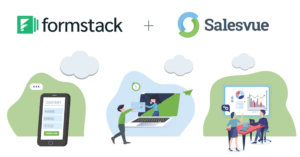Sales and marketing usually go together like orange juice and toothpaste, when they should go together like peanut butter and jelly. Why, after all these years, are there still headaches coming out of the relationship between sales and marketing? It should be simple right? Marketing finds the leads, then hands them off to sales and sales closes the deals. It doesn’t have to be any more complicated than that. This is why we’re here to help show how sales & marketing automation can help create efficiency and synergy between the two divisions and help boost your efforts.
Marketing Automation Benefits
Marketing automation can pay huge dividends. We don’t mean automating which colors to pick in a logo or which events to sponsor. Rather, it’s automating the contact avenues that you reach prospects by. For example, it’s coordinating marketing efforts across email, social media, text and web advertisements.
This automation plays a few key roles. First, it helps create brand awareness. If prospects are seeing your brand on their LinkedIn feeds, their Google ads, their emails and more, they’re more likely to recognize your brand when a seller reaches out to them. Second, it makes your efforts seem more personalized. Rather than thinking a seller is taking a shot in the dark, a prospect may think about how they’ve seen the company before, so the company has done their research and has a specific benefit to offer.
Sales Automation Benefits
Sales automation helps eliminate wasted time in a seller’s day. By automating the low-level tasks that bog up a big portion of a seller’s day, you allow them to focus more on the high-value tasks that lead to converting more deals. Why would you want your sellers taking time to update the CRM, send dozens if not hundreds of emails and figure out who they have to call that day? All of these can be done automatically with the proper tools. Imagine how much more efficient and effective your sellers could be if they could focus more on meetings and demos.

How Do You Automate Sales and Marketing?
The big question is how do these two types of automation work together? Knowing that you need automation in both is the first step. The next step is actually implementing them for your organization. Our tip, leverage marketing and sales automation tools in your efforts. Here’s our suggestions for which tools to leverage.
Marketing Automation Tools
Formstack
Formstack helps provide information from inbound leads. With Formstack, you can track and collect data about people who use your services. They fill out forms to get access to things such as demos, white pages, case studies and more. From here, their information can be sent straight to Salesforce, alerting sellers that an inbound lead was created.
HubSpot
HubSpot can help align your marketing efforts. With HubSpot, your marketing team can track and create content for multiple channels, monitor SEO to help boost your visibility and track ads. All of which help align efforts towards targeting the right audience at the right time.
Sales Automation Tools
Salesvue
The sales automation tool we’d recommend is Salesvue. Salesvue helps eliminate the low-level tasks we talked about earlier. With Salesvue, you can create cadences to stay organized and on top of what needs to be done. Also, your efforts are automatically updated in Salesforce, since Salesvue lives natively within Salesforce as a sales engagement platform. Once your marketing automation tools help funnel leads to your CRM, Salesvue can help organize them and systematize the best practices for going after them effectively.
For example, when a new lead from a form on your website comes in, they are automatically put in a follow-up cadence. This creates a call or email task for a sales rep. With Salesvue, you can avoid inbound leads slipping through the cracks.
Sales Automation in Salesforce
Many teams are currently using Salesforce. As we just alluded to, some sales automations tools, like Salesvue, are made specifically for that platform. So, you may ask yourself, can Salesforce be used for marketing automation too? The short answer we’d provide is Salesforce is a great tool that brings all your automation together, but in and of itself is not great for marketing automation. Starting from gathering an inbound lead to creating tasks to connect with them, Salesforce can act as the hub for all the tools needed to achieve this.
Specifically to sales automation, the main benefit is living in a single space. We all know how vast and powerful Salesforce can be. So, this is why Salesvue created a system that can align all your tools and efforts into a seamless process within Salesforce. For those teams using Salesforce already, help both marketing and sales by keeping everything in a single platform.

Summary
Relieving headaches between marketing and sales seems like an impossible task. However, we can assure you it’s possible. Your marketing team can help themselves by leveraging a marketing automation tool. These tools help streamline their efforts by making sure the content that gets pushed out and the touchpoints they create are both wide-ranging and also complementary. Sales automation tools help sales teams free up time in their day and focus more on their high-value tasks. The key is aligning these tools together.
By making sure your marketing automation tools talk to and work with your sales automation tools, you can make sure more leads are given to sales and less slip through the cracks. Better yet, there’s greater accountability and eliminate the finger pointing that can arise between the two departments. When used together correctly, sales and marketing automation can boost your team’s efforts by providing not only more leads, but better leads, and feeding them directly into a system where sellers can hit the ground running.
Category
Tags
Subscribe to Funnel Vision
Get the latest and greatest right in your inbox






